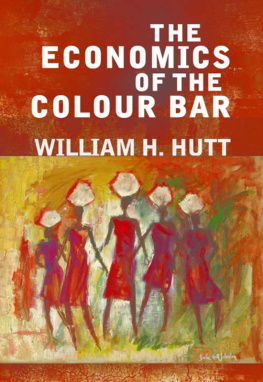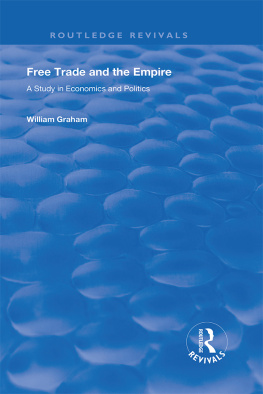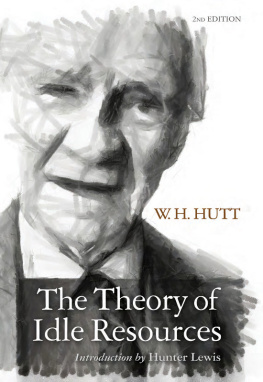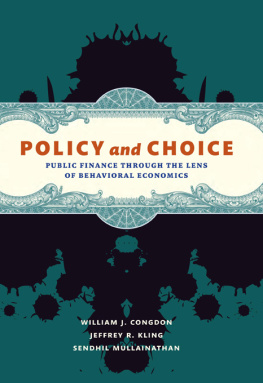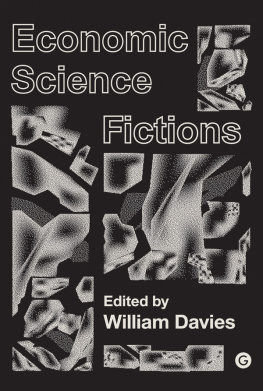William H. Hutt - The Economics of the Colour Bar
Here you can read online William H. Hutt - The Economics of the Colour Bar full text of the book (entire story) in english for free. Download pdf and epub, get meaning, cover and reviews about this ebook. year: 1964, publisher: The Institute of Economic Affairs Limited, genre: Politics. Description of the work, (preface) as well as reviews are available. Best literature library LitArk.com created for fans of good reading and offers a wide selection of genres:
Romance novel
Science fiction
Adventure
Detective
Science
History
Home and family
Prose
Art
Politics
Computer
Non-fiction
Religion
Business
Children
Humor
Choose a favorite category and find really read worthwhile books. Enjoy immersion in the world of imagination, feel the emotions of the characters or learn something new for yourself, make an fascinating discovery.
- Book:The Economics of the Colour Bar
- Author:
- Publisher:The Institute of Economic Affairs Limited
- Genre:
- Year:1964
- Rating:4 / 5
- Favourites:Add to favourites
- Your mark:
- 80
- 1
- 2
- 3
- 4
- 5
The Economics of the Colour Bar: summary, description and annotation
We offer to read an annotation, description, summary or preface (depends on what the author of the book "The Economics of the Colour Bar" wrote himself). If you haven't found the necessary information about the book — write in the comments, we will try to find it.
The Economics of the Colour Bar — read online for free the complete book (whole text) full work
Below is the text of the book, divided by pages. System saving the place of the last page read, allows you to conveniently read the book "The Economics of the Colour Bar" online for free, without having to search again every time where you left off. Put a bookmark, and you can go to the page where you finished reading at any time.
Font size:
Interval:
Bookmark:

THE ECONOMICS OF THE COLOUR BAR
The Quinten & Marian Ward
and William W. Massey Libraries of the
Ludwig von Mises Institute
Gift of
The Center for
Libertarian Studies
Ludwig von Mises Institute
518 West Magnolia Avenue
Auburn, Alabama 36832
NOT TO BE REMOVED
The Economics of
the Colour Bar
A study of the economic origins and
consequences of racial segregation
in South Africa
W. H. HUTT

Published for
THE INSTITUTE OF ECONOMIC AFFAIRS
by
ANDRE DEUTSCH

FIRST PUBLISHED IN GREAT BRITAIN
1964
ANDRE DEUTSCH LIMITED
105 GREAT RUSSELL STREET
LONDON WCI
THE INSTITUTE OF ECONOMIC AFFAIRS LIMITED
ALL RIGHTS RESERVED
PRINTED BY
Merritt & Hatcher Ltd., London, S.E.10
Chapter
Professor W. H. Hutt has written this book as an economist. His central discussion is of economic causes and consequences and he touches only marginally on other aspects, political, sociological, philosophical.
Readers may differ from some of the judgments on non-economic aspects of the subject, but the Institute considers that Professor Hutts effort to explain apartheid makes a new contribution to the debate that has been overlooked both by supporters and opponents. It does not necessarily accept his argument or conclusions, but believes he has written an informed, stimulating and controversial history and analysis of apartheid that can do nothing but good if it provokes discussion and re-appraisal of uncritical attitudes on all sides.
The central theme is that if the English in South Africa had continued the development of a liberal economy, it would have prevented or ameliorated the racial tensions that have been exacerbated by the restrictionist policies arising from the Nationalist Governments racialist doctrines and the efforts of the higher-paid white workers to protect privileged positions in the labour market.
Although Professor Hutt writes dispassionately as an academic, there is ample evidence in his record of public protest of his moral revulsion against the injustices to the non-white peoples of South Africa.
| November, 1963. | I.E.A. |
THE argument of this essay is illustrated mainly by reference to policies and conditions in the Republic (formerly the Union) of South Africa. Through the pressure of world opinion and the force of internal criticism, these policies and conditions are currently in process of significant modification some changes being in a seemingly liberal direction and others in a seemingly totalitarian direction. The changes have been continuing whilst this book has been in the press; but its purpose is not to provide an up-to-date account of the racial situation in South Africa. It simply uses the experience of that country in an attempt to expose the ultimate origins of colour injustices generally. Similar origins can, I suggest, be discerned for all colour, racial, caste, class or similar injustices wherever they may exist.
| March 1964 | W. H. HUTT |
WILLIAM HAROLD HUTT was born in 1899. He was educated in London and served in the R.F.C. and R.A.F. from 1917 to 1919. After the war he studied at the London School of Economics. He worked for several years with Benn Brothers, London, and joined the University of Cape Town in 1928. He was appointed Professor of Commerce and Dean of the Faculty of Commerce in 1931 and has held this post ever since.
He has written several works on theoretical and applied economics. His books include The Theory of Collective Bargaining, 1930; Economists and the Public, 1936; The Theory of Idle Resources, 1939; Plan for Reconstruction, 1943; KeynesianismRetrospect and Prospect, 1963. He has also written numerous articles in economic journals, including several dealing with economic aspects of South African colour problems.
Professor Hutt has long been a critic of racial policies in South Africa. His fears were aroused before the election in 1948 of the Afrikaner Nationalist Government. Through the Statute of Westminster (1931) the British Government had relinquished effective control over the constitutional development of South Africa. The 1934 South African Status Act took a further step in this direction and in 1937 Professor Hutt tried to arouse South African public opinion to the danger that the entrenched clauses in the constitution, which safeguarded inter alia the right of coloured men in the Cape to vote on the common roll, were being under-mind. He warned his adopted country through the columns of the Cape Times that it had carelessly torn up its constitution. For this he was rebuked by the paper for irresponsibility. Since 1948 Professor Hutt has consistently opposed the South African Governments policy of apartheid.
In 1955 his passport was withdrawn by the Department of the Interior but returned after the matter had been raised in Parliament. In 1961, as South Africa was seceding from the Commonwealth, he argued in The Times that all South African citizens, irrespective of race, colour or creed should be offered British citizenship.
It is a striking historical fact that the development of capitalism has been accompanied by a major reduction in the extent to which particular religious, racial, or social groups have operated under special handicaps in respect of their economic activities; have, as the saying goes, been discriminated against. The substitution of contract arrangements for status arrangements was the first step toward the freeing of the serfs in the Middle Ages. The preservation of Jews through the Middle Ages was possible because of the existence of a market sector in which they could operate and maintain themselves despite official persecution. Puritans and Quakers were able to migrate to the New World because they could accumulate the funds to do so in the market despite disabilities imposed on them in other aspects of their life. The Southern states after the Civil War took many measures to impose legal restrictions on Negroes. One measure which was never taken on any scale was the establishment of barriers to the ownership of either real or personal property. The failure to impose such barriers clearly did not reflect any special concern to avoid restrictions on Negroes. It reflected rather, a basic belief in private property which was so strong that it overrode the desire to discriminate against Negroes. The maintenance of the general rules of private property and of capitalism have been a major source of opportunity for Negroes and have permitted them to make greater progress than they otherwise could have made. To take a more general, example, the preserves of discrimination in any society are the areas that are most monopolistic in character, whereas discrimination against groups of particular colour or religion is least in those areas where there is the greatest freedom of competition.
MILTON FRIEDMAN, Capitalism and Freedom
WHY DO the non-white peoples of the world today enjoy a much lower average standard of material well-being than the white peoples? The answer is compounded of history, climate, custom, powerful inertias, insecurity for investment, and legislative barriers to employment. How far can their inferior economic status be said to be caused by natural handicaps and how far by injustice at the hands of white people? Usually there is a mixture of causes.
Font size:
Interval:
Bookmark:
Similar books «The Economics of the Colour Bar»
Look at similar books to The Economics of the Colour Bar. We have selected literature similar in name and meaning in the hope of providing readers with more options to find new, interesting, not yet read works.
Discussion, reviews of the book The Economics of the Colour Bar and just readers' own opinions. Leave your comments, write what you think about the work, its meaning or the main characters. Specify what exactly you liked and what you didn't like, and why you think so.

